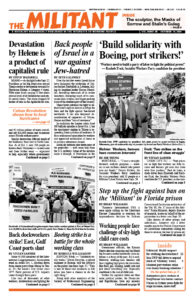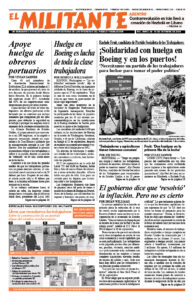Government officials, the Kamala Harris election campaign and the liberal big-business media repeatedly claim inflation is a thing of the past. All is well. However, working-class families still face crippling high prices for necessities like food, gas, housing, health care and just about everything else. Especially exorbitant is the cost of child care.
Neither the capitalist rulers nor their main political parties, the Democrats and Republicans, have any answers to this crisis. Both of their presidential candidates, Kamala Harris and Donald Trump, say they will try to offer taxpayers some version of tax credits for their children. But this would be woefully inadequate to address the deepening social and economic crisis working people face in affording to raise a family and having the time to do so.
Day care costs rose 6.2% over the past year, more than double the rate of overall inflation. And this comes on top of years of price hikes. Child care costs have risen over 220% since 1990.
According to the Department of Labor, families on average spend over 25% of their income paying for child care. In New York, child care costs now average nearly $20,000 a year, the Century Foundation reports. Such prices are out of reach for 80% of families living in the city. Some families are pushed out of the area desperate to reduce these costs. Others go deeper into debt.
Day care costs more than rent
The average cost of child care for two children, which the majority of U.S. families have, is greater than the average price of rent in all 50 states and of mortgages in 45 of them. “Childcare costs are a top economic concern for parents this election” headlined a Sept. 22 Washington Post article, expressing concerns about how this issue will impact the vote. The article focuses on Nevada, one of the states with the highest-priced child care in the country, where almost three-quarters of young children don’t have access to licensed care.
Alyssa Felix, 21, works six days a week making drawers at a furniture warehouse and often relies on her sister or her sister’s mother-in-law to care for her daughters, ages 2 and 3. She told the Post she often has to leave work early or take the day off to care for her children. Almost 70,000 U.S. workers missed work in August because of child care issues. Workers who face forced overtime, or night shifts, have even more problems.
“I want to look for a full-time job, but day care is very expensive. I can’t afford it,” Misty Grajeda, 29, told the paper. She quit her job scheduling health care appointments in Reno so she could take care of her infant child. To help accumulate some funds, she manages to spend a few hours delivering for DoorDash and Instacart in the evenings, after her husband is home from his job painting houses.
“I’m not a Democrat or a Republican. I believe in looking at the issues,” Sonia Kretschmer, a high school social studies teacher in Reno, told the Post. “Right now, it’s about child care.”
She and her husband, James, also a high school teacher, pay $2,700 a month for preschool for their 3-year-old twins and before- and after-school care for their 8-year-old son. “They’ve borrowed against their home, taken on extra work coaching soccer and bartending, and racked up credit card debt to make ends meet,” the Post reported.
When another Nevada couple, Kayla and Ryan Frost, went to work they paid the dog sitter for their German shepherd to also keep an eye on their 3-month-old daughter. But it soon became apparent this wouldn’t work. “We need more help than this,” Kayla Frost told the paper. “We limped along for half a year. We stopped working as much. We were exhausted. It really took a toll.” She was an insurance agent and her husband a mechanic.
The big money that people have to shell out doesn’t go to the child care workers. They face low pay and extra challenges due to a shortage of workers. Median pay nationally for a certified child care worker was $13.71 an hour in 2022. That means a quarter of these workers in New York live below the official government poverty line.
The crisis was exacerbated by the pandemic that caused 16,000 child care centers to shut down permanently. Then, in September 2023, the Joseph Biden administration cut off the $24 billion in federal funding provided during the pandemic that helped keep hundreds of thousands of remaining child care centers open. This has led to even more closures, higher prices at those that are still open, increasing number of “deserts” — areas where no child care is available — and deteriorating working conditions for the workers providing the care.


